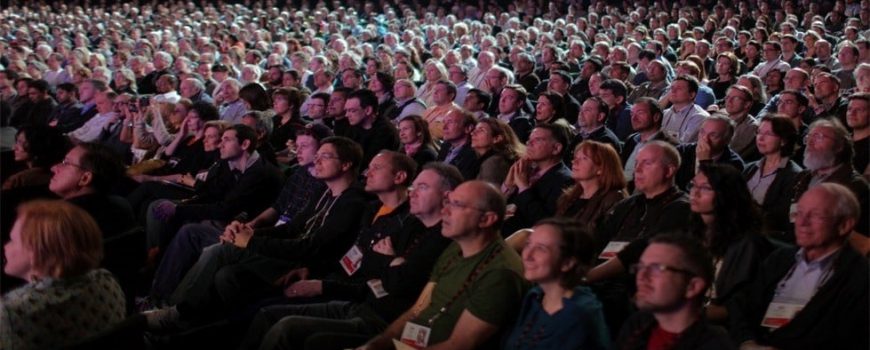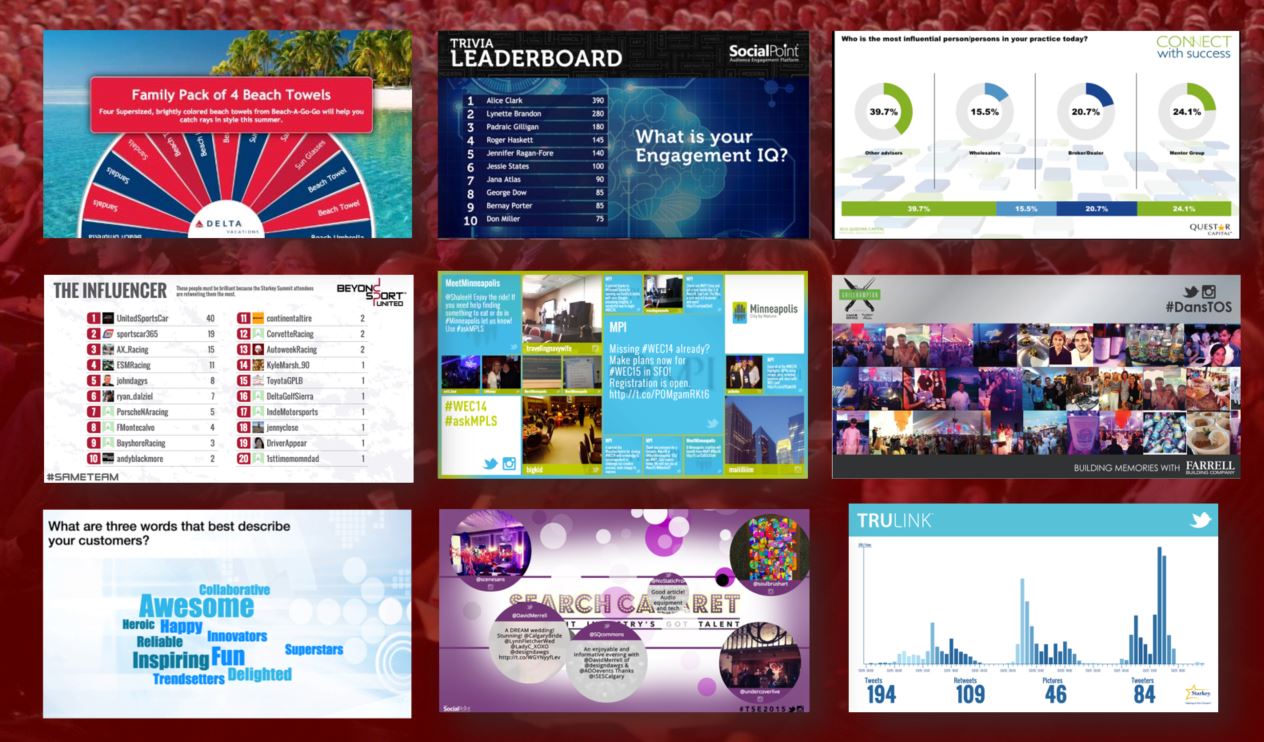What Is Audience Engagement For Events?
At their best, events are an explosion of content and ideas where we craft meaningful stories and create community.
However, events are also where we too often load everybody up with as much coffee as we can give them and then send them into a big, dark room with rows and rows of chairs to watch the CEO’s presentation up on a big screen!
Most attendees stop paying attention after 10 minutes
As an event professional, you probably know that most attendees stop paying attention after 10 minutes! We polled event professionals at a recent webinar, and 85% of the participants knew that attendees lose their attention after just 10 minutes. And yet, so many meetings don’t seem to take that key fact into account when creating their conference content and agenda. (Read 20 reasons people attend conferences)
Lecture and listening are the least effective forms of knowledge transfer and learning
Better than sitting and listening is when people get to talk about something or when they get to do it, those are the best forms of learning. So even just creating conversation in your event, where people get to talk and they get to show that they’ve understood the content or can assign meaning to it verbally, that’s a good form, but also more importantly, they can do something.
We all learn from the mistakes we make, that’s the most effective form of learning. But in an event, we can’t always get people to do stuff. We do have to do some kind of role-playing or trial and error or try some other techniques. (Read – How to Prepare Speakers to use Audience Response Apps for Greater Attendee Engagement)
Yet, we ask attendees to listen quietly for 4 to 6 hours per day at the average conference
Also, I want you to think about this — not only do people stop paying attention after 10 minutes, but we ask attendees to stay quiet in their chairs for way more than that. If you look at your conference program and your educational sessions, you’ve probably have several blocks of educational content. You’re going to see that you’ve got people sitting and listening for four to six hours!
And so, the challenge I have for you is to see what can you do inside those blocks to change that from a listening-only educational session, to one with different, better types of engagement. If you can even find 10 or 15 minutes or some activities that you can put into those education sessions, you’ll transform your program dramatically. (Read How to Manage Interactive Q&A with an Audience Response App)
What is the definition of audience engagement?
A lot of people use the word “engage.” Everyone is saying “engage this,” “engage that,” and they share lots of statistics, some dubious. I saw one company saying, “Hey, if you click on the agenda of an event app, that’s engagement!” I don’t think so but let’s see what the definitions are, according to the Cambridge Dictionary.
Skipping the number one definition of engagement (which is about getting married), engagement is the act of being involved with something or the process of encouraging people to be interested in the work of an organization. That’s engagement. How do we apply that to events?
We have all these attendees in our event, and to better understand them, you could probably do demographic research and discover how many Boomers and Generation Xers there are, and males and females, and how many people are buyers and sellers, and lots of other types of demographic analysis.
But what I want you to take a look at is a tool we use for looking at attendee behaviors, rather than demographics. It’s something we adopted several years ago from the book Groundswell and have modified it to suit our needs.

We have the attendee behavior in the left column, and next to that is a description of their behavior. (If there’s one image that you should right click on and save it for later, this is it! Do it right now; this is the one.)
So, if you think about what a Creator is in an event space, these are the people that make things. You probably have met people that, if you give them a blank piece of paper, they can create something amazing.
But you’ve also met people that critique rather than create. For example, if you’ve worked extremely hard on a 40-page report or an analysis or a presentation or whatever it is, and you show it to them and they in turn tell you why what you made was the worst thing in the history of the world. (I bet you are thinking, “Yeah, I’ve been there before,” because you have run into a Critiquer.)
What’s interesting is you’ve got Creators that will create stuff from scratch, but a Critiquer, they need something to start from. They can’t start with a blank piece of paper, they need a base to launch off. They build off of an idea. So, you’ve got to think about those folks as attendees.
There’s also the Collector. This is the person that wants to run around and visit all the booths and try to collect everything, be it buttons or glasses or whatever. But notice what the chart says: They’re motivated to collect a set of things. This is a mistake I see people make all the time is put on scavenger hunts but give people points. A collector doesn’t care about points! They want to collect a set. They want to say, “I did it! I want my accomplishment of collecting everything!” That’s what makes Collectors happy. So, consider how you would engage Collectors in your event.
Attendee types are also Sharers and Joiners and then of course, the Spectators/Inactives. Now let’s admit it, there are people out there that will do everything they can to avoid participation. And it’s okay, because some people just need to observe. It’s okay to acknowledge that they’re not going to do something.
So, these are your behaviors and if you were to break down the activities that you create in your event by these behaviors I bet you would find some gaps and opportunities at the same time. Opportunities for you to kind of change your event and think of some new things to try to appeal to these different folks.
Attendees need to take action
If you’re going to create something to appeal to these different types of people what kind of action do they need to take? These are some action words that I think help: ask, answer, poll, rank, vote, play, capture, collect, display, share. And yet, nowhere in here is “sit and listen!” These are things you want people to do and so if you as you’re building a program if you don’t have these types of action words in there you need to figure out how to get them. (Read 10 Audience Engagement Ideas Beyond Live Audience Response Polling)
You need to provide feedback to your attendees
Now taking action is one element, but there’s a second element that’s super important and that’s providing feedback. When I participate and ask a question, you better answer my question or acknowledge that you received my question. So, if your attendees send in 50 questions, you need to say, “Today we’re probably not going to be able to answer all 50 questions, but we’re going to do the best we can to answer these now and we’ll get to the rest of you later.” That’s something your attendee should expect as a commitment.
There are ways to provide that feedback continuously and automatically with technology. You can show your attendees a polling result, or a Word Cloud, or a live Social Media Wall. A Social Media Wall shows attendees where the social media conversation is and can help increase calls to action. Sometimes people don’t think about their individual Tweet as having a role in the bigger picture but they will when they see your event’s social posts on a social media wall. Or, putting photos whether it’s social media or private social messages on a big screen, people love that, they also like leaderboards. Similarly, a Trivia Game leaderboard can really drive your engagement. People love to see their name in lights and they want to see their picture. They may even want to see their picture more than their name!
So, as you create activities to increase engagement, consider both the actions they should take and that you need to provide feedback. (Read 10 New Ways To Visualize User Generated Content)
Rather than stuffing people into rows of chairs for hours on end, remember that what your event goal is — to create audience engagement. If you can in turn your attendees into active participants and create conversations, you’ll succeed. And hopefully this article has given you new ideas and different technology ideas to change how you think about planning for your audience.
If you’d like to see how you can create more engaging and interactive content using the wide variety of choices within our SocialPoint Audience Engagement System, feel free to contact us with questions or to discuss your event with one of SocialPoint’s Digital Strategists. We’ll help you generate greater attendee engagement at your events.


